Placemaking thoughts from around the country (Seattle, Texas, Philadelphia, Los Angeles)
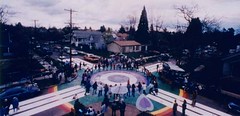 A City Repair intersection "taking" in Portland, Oregon.
A City Repair intersection "taking" in Portland, Oregon. In "Placemaking brings neighbors out of the house, and into the community," the Seattle Post-Intelligencer reports on the efforts of City Repair Seattle, which must be an offshoot of the original City Repair group in Portland.
City Repair Seattle is part of the Greenwood/Phinney Placemaking Alliance, which includes neighborhood, environmental and business groups. The alliance received a $10,500 matching grant from the city last year to promote placemaking. "We're a resource for neighborhood groups to help them create their own gathering places," Shick said. Thomas Whittemore, a project manager in the city Department of Neighborhoods, said placemaking draws on an old idea, evoking a sense of a town square.
The idea is to bring people out from their houses and back to the street," he said. "It used to be that kids played in the street and people worked on cars in the alleys. We're saying, let's move slowly back out and regain our streets and our neighborhoods. Let's do it in an intriguing way that shows a sense of identity and maybe a sense of humor."
Note: Dan Tangherlini hasn't replied to my idea of trying to do this to Florida Avenue NE, where the cars speed like demons. (See the blog entry "Taking (it to) the Streets" about the Re:Bar project in San Francisco. The photos are from Re:Bar.)
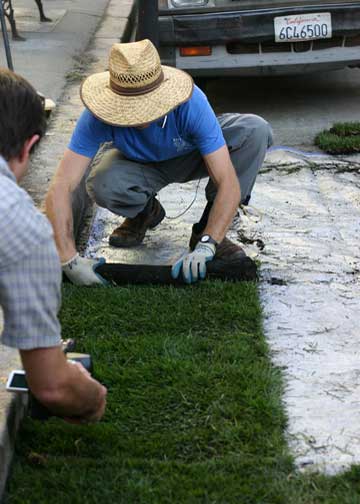
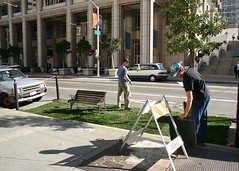
Last week, I was introduced to a column in the Fort Worth Star-Telegram that focuses on Arlington Texas, home of the Texas Rangers, between Dallas and Fort Worth and the newspapers from each of those cities fight for readers in Arlington. The Star-Telegram trolls for readers through the columns by O.K. Carter, who writes about the city, focusing it appears on urban design and placemaking issues.
His column, "Cities mustn't leave design to chance," discusses a local landscape architect and his foray back to school for a masters degree in planning. Mr. Williams' thesis, Places to Flourish: Placemaking that Nurtures Ideas, Creativity and Commerce, has a lot to offer, and I want to try to track it down. From the article:
"I do think it's possible to plan and design a place which, over time, fosters a creative community and atmosphere," Richards says. It's a concept that prompted his thesis, essentially a documentation of his travels to "three creative-class meccas" -- Seattle, Washington D.C., and Austin -- the idea being to get a grip on urban design concepts and physical planning that attract highly educated, entrepreneurially zealous residents. It's a premise that Richards borrowed and simplified from urban studies scholar Richard Florida's Flight of the Creative Class. He has basically translated Florida's work into a less esoteric and eminently more practical "toolbox of ideas." ...
Those guiding principles?
Design for diversity: Richards defines this as being about much more than race. "We're talking about ethnic, cultural, socioeconomic and environmental diversity, coming together in ways that provide interesting juxtapositions of viewpoints and experiences," he says.
Design for choice: Appealing cities, Richards says, provide prospective residents "a range of attractive alternatives for everything from housing to transportation options, from working environment to leisure-time pursuits."
Design for authenticity: This includes attributes such as preserved natural features, older buildings, traditional self-contained neighborhoods and a predominance of independent, locally owned businesses over ubiquitous franchises.
Design settings for a vibrant public life: A city culture of public life should extend beyond typical park-and-recreation pursuits to include, Richards says, "a variety of choices for dining, shopping, schmoozing, exercise, informal meetings, people-watching and walking."
Design a stimulus-rich environment: Richards believes that walkability guru Dan Burden had it right when he observed that "A great street has 1,000 points of detail." To attract the most critical agent of urban energy -- people -- a city should consistently engage the senses and intellect through design that includes scale, rhythm, repetition and color as well as "cultural stimuli from street performances to public art."
Richards offers more than 20 practical how-to examples, too many to include here. Arlington is ignoring some of those concepts while clearly moving toward others, albeit in agonizingly stop-and-start fashion. "The reshaping of an existing urban environment happens every day with every street widening, infill or park project," Richards said. "And each of those projects either builds toward an environment friendly to creative opportunity or works against it."
Sounds familiar. But as we build our knowledge base and constituency and rebuild the understanding of urban design and placemaking principles appropriate to the city, we can go forward.
Speaking of this, there's an excellent letter to the editor in Monday's Philadelphia Inquirer, in response to the two-part series from a couple week's ago, "Center City Renaissance."
Jeff Prant, now living in Brooklyn, writes:
Philadelphians are justifiably proud that Center City is increasingly becoming a truly vibrant place ("How to maintain the momentum," Dec. 28). The quality of this urban experience is the legacy of an environment that largely predates the automobile and which brilliantly serves the needs of the pedestrian. Unfortunately, recent efforts to accommodate the city to the automobile, such as the creation of many new parking facilities, undermine Philadelphia's claims to being the next great 21st-century city. Ultimately, a city can't sustain a dense, walkable community if it continues to plan like a 1950s car-centered suburb.
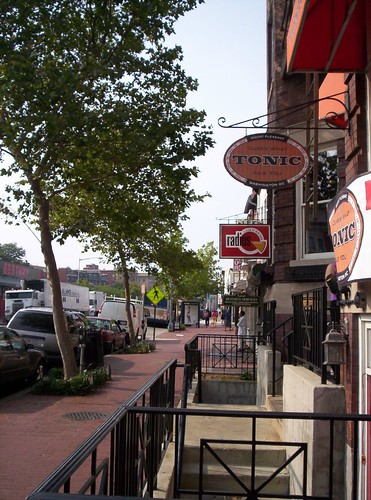 Mt. Pleasant Street NW, Washington, DC.
Mt. Pleasant Street NW, Washington, DC.Now if we could fertilize better and spread that lesson around the City of Washington.
 L'Enfant Plan, Washington, DC.
L'Enfant Plan, Washington, DC.Finally, Harold Meyerson writes in today's Post about Los Angeles(!) and its new mayor, Antonio Villaraigosa, in the column "In L.A., Visibility And a Vision." Meyerson writes:
There's more to his visibility, though, than his story and his schedule. For he has become mayor at the very moment when Los Angeles seems finally to have realized that privatized, unplanned sprawl no longer works, that decent private lives depend on a decent public environment. Fifteen years ago, the residents of the city's tony Westside rejected the idea of a subway running down Wilshire Boulevard to the ocean: Their neighborhoods didn't need the transit or the polyglot riders who'd be tromping through their part of town. Today, having spent much of the intervening time stuck in ever-worsening traffic, the Westsiders are calling for a subway, and Villaraigosa is lobbying Washington and Sacramento for the funding.
If they can learn in Los Angeles, we have no excuse anywhere else, if we refuse to learn from the signals we are getting from our built environment.
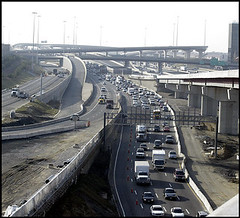 The Springfield Mixing Bowl will be largely untangled in 2006 with the opening of three bridges linking I-95 and the Beltway. Photo Credit: By Kevin Clark -- The Washington Post. From the article "Some Headway Against Gridlock."
The Springfield Mixing Bowl will be largely untangled in 2006 with the opening of three bridges linking I-95 and the Beltway. Photo Credit: By Kevin Clark -- The Washington Post. From the article "Some Headway Against Gridlock."Index Keywords: urban-design-placemaking



0 Comments:
Post a Comment
<< Home